Tower and the Glory
It is the tallest hotel in the world and one of the most astonishing
architectural wonders of the planet.
Al Shindagah turns the clock back to talk to some of the men behind the
construction of Dubai's Burj Al Arab
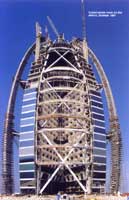 When the Burj Al Arab opened its gold laden doors for business just
before the turn of the millennium, the hospitality world gasped at its
magnificence. Towering over the Arabian Gulf and taller than the Eiffel
Tower, the 321-metre luxury hotel saw the world's travel writers run out
of superlatives for a construction which has become a symbol of Dubai's
drive to be one of the most modern cities in the 21st century.
When the Burj Al Arab opened its gold laden doors for business just
before the turn of the millennium, the hospitality world gasped at its
magnificence. Towering over the Arabian Gulf and taller than the Eiffel
Tower, the 321-metre luxury hotel saw the world's travel writers run out
of superlatives for a construction which has become a symbol of Dubai's
drive to be one of the most modern cities in the 21st century.
People from Argentina to Australia had heard about this futuristic tower
'growing' out of a man-made island off the coast of Jumeirah, but no-one
could have possibly imagined the finished product would have attracted
such a captive audience of admirers.
It is quite simply fabulous. Its shape has been erected to resemble the
sail of the traditional fishing dhow, ensuring a vision of the future
retains a foot in the past with Arabian heritage recalled in a masterly
way throughout its breathtaking interior.
Mid 20th Century movies imagined we would be living in buildings like
this in hundreds of years time, little did they know that the
construction industry would advance at such a pace to the heights of the
Burj Al Arab ? The Arabian Tower.
Much of the credit for its construction lies at the door of a
partnership that was forged to tackle this immense project, and has
matured to become a major player in the country's construction industry.
In a marriage that set the construction industry alight in the UAE, Al
Habtoor Engineering tied the knot with Murray & Roberts to form a Joint
Venture capable of performing wonders off the Jumeirah coastline. To the
uninitiated, the question "where do you start?" would spring to mind but
the hard work began for the Joint Venture long before the first cubic
metre of concrete had set.
Nigel Poole, Contracts Manager for Al Habtoor Engineering, was a member
of the Joint Venture Board which successfully bid for two of the
project's main contracts that were put out to tender to some of the
world's largest and most reputable construction companies.
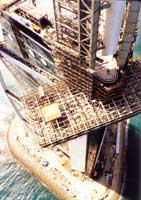 "The hard work for the Joint Venture began long before the building work
commenced," said Poole, a Habtoor employee since 1977 and the driving
force behind some of the UAE's most notable landmarks.
"The hard work for the Joint Venture began long before the building work
commenced," said Poole, a Habtoor employee since 1977 and the driving
force behind some of the UAE's most notable landmarks.
"The overall project manager was WS Atkins & Partners Overseas which let
it out to tender in four packages. First was the island up to ground
floor slab; second was the superstructure; third was the mechanical,
electrical and plumbing contract; and the fourth was the fitting out to
the suites. The Al Habtoor, Murray & Roberts Joint Venture was
successful in bidding for the second and fourth parts, which was a major
achievement considering we were up against some formidable companies
from across the world. It was just reward for some hard work and looking
back it was probably the biggest part of the job!"
With the contracts signed, the Joint Venture then had to set about
turning drawings and models into the multi-million dollar construction.
This was where the new partnership really blossomed. "The teamwork from
the start was exceptional," said Poole. "We assembled a first-class team
of managers and the job went to plan without any major hitches. It was
an incredible team effort."
The concrete island, which has its foundations some 40 metres beneath
the seabed, was completed in March 1996 and the baton was handed over to
the Joint Venture which commenced work on April 11, 1996. "I remember
the day well because it was one of our quantity surveyors' wedding day
and the reception was held at DIMC further down the coast. I remember
that I kept looking up the coast at the site and wondering how the
coastline would look with this enormous construction.
"The time it took to execute phase one (the island) gave us six months
to further plan and look at how we could speed things up. We purchased
three Favelle Favco 760 cranes which are among the biggest in the world.
We needed these to lift the huge sections of steel that make up the
building's unique exoskeleton. These cranes are capable of lifting 12
tonnes at 60 metres and made the job a lot easier. This meant we could
make the rooms at ground level and simply lift them into place.
"It was a mammoth job and from start to completion it took us almost two
years to complete. In principal it was finished on time too." Outside
help was required to erect such a complicated high rise building and the
Joint Venture acquired the services of a project manager and
construction supervisor from New Zealand company Fletcher Construction,
which was going to be a part of the joint venture but pulled out at the
eleventh hour when the company decided to freeze its overseas projects.
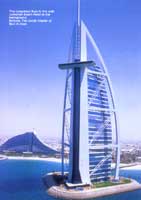 Both men had vast experience in erecting sky-scrapers and became an
integral part of its planning and organisation.
Both men had vast experience in erecting sky-scrapers and became an
integral part of its planning and organisation.
Andy Durrant, of Murray & Roberts, was appointed as the engineering
manager, his first posting in Dubai since switching from the company's
base in South Africa.
"The initial structural job was extremely challenging but exciting at
the same time," he said. "The complexity of the task helped to forge a
strong joint venture between the two parties involved."
Poole pointed out that the massive exoskeleton posed the biggest test to
the Joint Venture's team of experts but concluded that it was a
challenge accomplished with considerable style.
"The hardest part was the diagonal steel trusses which weigh 185 tonnes
each," he said. "They are 85 metres long and were made in Jebel Ali; we
had some fun transporting them along the highway too! It was very
complex because all these huge trusses had to meet up in the middle with
no margin for error. Thankfully we got our sums right and it all slotted
together."
There was little time to sit back and marvel at the work carried out
over the previous two years as there was another important task at
hand... the fitting out of the hotel's 202 luxury suites. These were the
touches that would see Burj Al Arab become the world's first seven-star
hotel and Poole was well aware that this was probably one of the most
important parts of the job.
Durrant was handed the role of project manager for this particular part
of the job and set about the task as soon as his role as engineering
manager for the structural part was over.
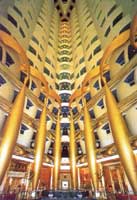 "The fitting out and furnishings stage was by far the most challenging
part of the project," said Durrant. "We went just about everywhere for
the materials we needed. There were hundreds of fabrics required and
silks from all over the place. I think this part of the job broke new
ground and no-one really knew how it was going to turn out. It felt
really good when it was finally finished."
"The fitting out and furnishings stage was by far the most challenging
part of the project," said Durrant. "We went just about everywhere for
the materials we needed. There were hundreds of fabrics required and
silks from all over the place. I think this part of the job broke new
ground and no-one really knew how it was going to turn out. It felt
really good when it was finally finished."
Exclusive marble from Brazil, leathers from Scotland and the finest
linen from Ireland were just two examples of their well-travelled
shopping trolley which left no stone unturned.
Poole added: "I remember we sent a senior man scouring the world for a
certain type of yellow leather which would make up the bed heads. He
went everywhere before finding what we were after. It was a very
difficult job ensuring we got the right products."
With the job completed, a picture of the Burj Al Arab takes pride of
place on Poole's wall which is adorned with the success stories of his
23-year career in the UAE. The novelty has not worn off either. "I still
look for it when I travel up from Abu Dhabi and I am sure that everyone
involved with it feels the same sense of pride as I do when I look at
it. It is a tremendous achievement and has become recognised throughout
the world as a symbol of Dubai's excellence."
But while Poole and a majority of the rest of the team has moved on to
projects new, Durrant is still tying up the final administrative loose
ends. The successful teamwork has spurred the Joint Venture onto other
projects, the most notable being the new US$600 million airport
concourse at Terminal One of Dubai Airport, which opened earlier this
year amidst a blaze of publicity. The Joint Venture is currently working
on the National Bank of Abu Dhabi Building and the Marina Mall in Abu
Dhabi. "We had a good team of managers working on this job from across
the world and it has ensured a strong team has been built from Al
Habtoor Engineering and Murray & Roberts," he said.
A Tour Of The Hotel
Reaching new heights of luxury, the all-suite Burj Al Arab provides
guests with an unparalleled experience of 21st century Arabic
hospitality, quite literally elevating expectations of service of the
most discerning guests to new levels.
Transfers from the airport are done via Rolls Royce Silver Seraph or via
helicopter, with a 15-minute birds-eye panorama of the city ending in a
dramatic landing on the hotel's helipad on the 28th floor. A burning
flame set amid flowing water provides a spectacular welcome in the lobby
where the guest experiences a kaleidoscope of colours, sights and
sounds. A sumptuous oasis of golds, reds and blues provides a visual
treat - in the strands of the hand-tufted carpet, highlighted by the
gold shells housing concierge and guest service staff, and all
illuminated by an intricate crystal chandelier.
Conveyed upwards to the main reception area, guests pass by a shimmering
waterfall, billows of dry ice and two glass-encased coral reefs, where
richly-hued fish provide a glimpse of the Arabian Gulf's variegated
marine life, to reach the world's tallest atrium. Flanked by golden
columns and reaching skyward the length of the "sail", the atrium, with
its 32-metre water column, takes the eye towards its peak far above the
guest.
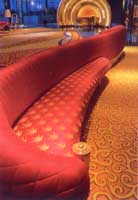 Individual service and personal attention are paramount at the Burj Al
Arab, with a private reception on every floor, as well as a butler
service for each one of the 202 duplex suites. The Al Habtoor, Murray &
Roberts Joint Venture played a huge role in the lavish interior with
each suite exquisitely crafted and appointed to achieve a degree of
comfortable luxury that aims to satisfy the senses of every guest, from
all corners of the world.
Individual service and personal attention are paramount at the Burj Al
Arab, with a private reception on every floor, as well as a butler
service for each one of the 202 duplex suites. The Al Habtoor, Murray &
Roberts Joint Venture played a huge role in the lavish interior with
each suite exquisitely crafted and appointed to achieve a degree of
comfortable luxury that aims to satisfy the senses of every guest, from
all corners of the world.
Suite names reflect the romance of the Arabian nights, inspired by the
opulence and splendour of precious stones and gems such as Feyrouz,
Zabarjad, Zumurud, Yakuta, Malakeet and Lazawerd.
Within the welcoming ambience and luxurious fittings of every suite lies
hidden a network of technological wizardry, fuelling a sophisticated
multi-media system that provides the largest selection of satellite
television channels available in the Middle East. Also provided is a
video-on-demand system, offering a wide array of filmed entertainment,
all of which can be enjoyed in surround-sound stereo on a wide-screen
42-inch plasma television in the lounge.
Convenience, luxury and a highly-personalised service are available for
every guest, whether staying in one of the 164 one-bedroom duplex suites
- at 170 square metres in size - or in any of the 28, two-bedroom
suites, or six suites housing three bedrooms. Topping them all are the
two Royal Suites and two Presidential Suites spread over 780 square
metres, each with palatial surroundings set on two floors joined by a
private elevator. These reach unsurpassed peaks of luxury, including
rotating beds, private cinema, majilis and even dressing rooms larger
than the average hotel bedroom.
Complimenting the superfluous range of accommodation are exclusive
restaurants offering the finest cuisine in dramatic surroundings,
whether it be hanging 200 metres over the Arabian Gulf in Al Muntaha -
Skyview Restaurant - or literally at the bottom of the ocean in Al
Mahara - Seafood Restaurant - where a three-minute submarine voyage
takes diners to their table from the hotel lobby.